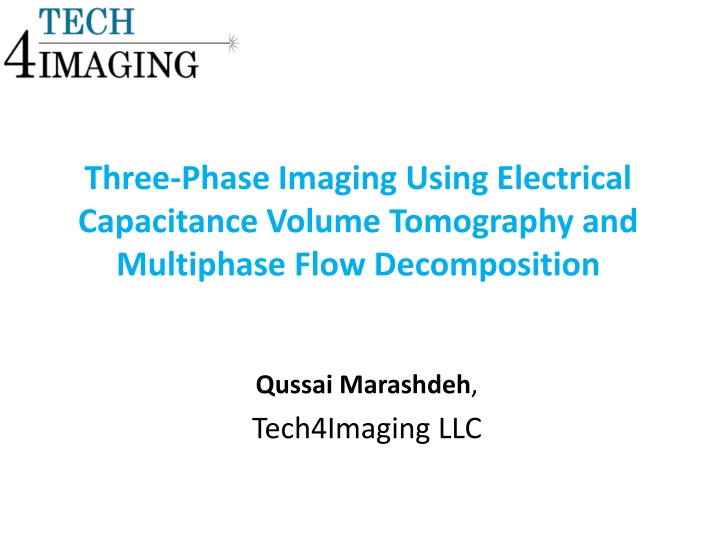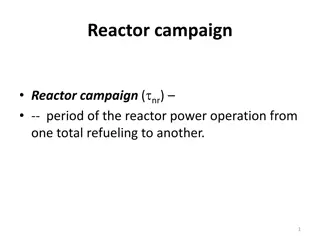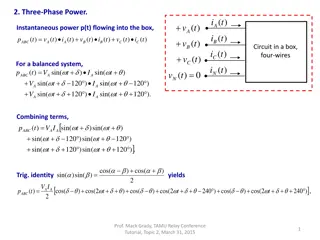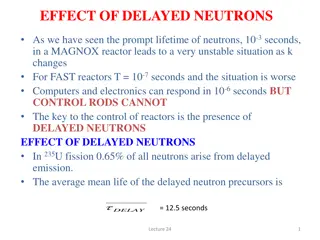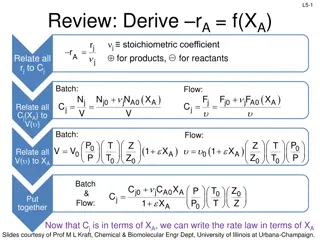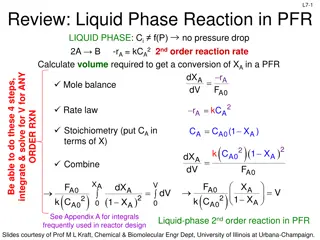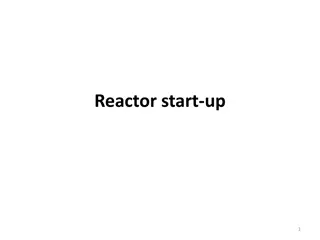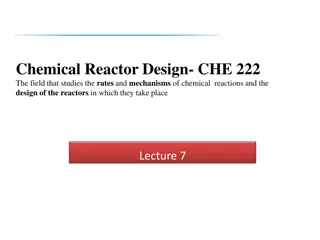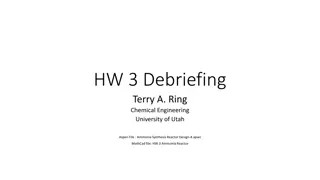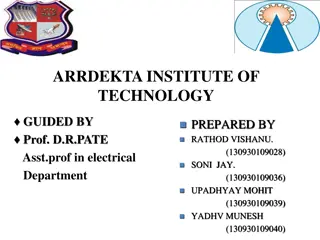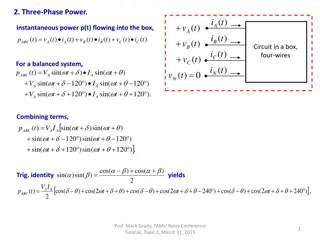Advanced Imaging Techniques for Three-Phase Flows in Reactor Systems
Gas-liquid-solid reactor systems require advanced measuring techniques to understand complex three-phase flows. Multi-Phase Flow Decomposition using Electrical Capacitance Volume Tomography (ECVT) offers innovative solutions for visualizing and quantifying phase hold-up distributions and dynamic characteristics. This technology addresses the instrumentation needs of three-phase applications, providing insights into velocities, volume fractions, mass flow rates, catalyst volume estimation, and reaction rates.
Download Presentation

Please find below an Image/Link to download the presentation.
The content on the website is provided AS IS for your information and personal use only. It may not be sold, licensed, or shared on other websites without obtaining consent from the author.If you encounter any issues during the download, it is possible that the publisher has removed the file from their server.
You are allowed to download the files provided on this website for personal or commercial use, subject to the condition that they are used lawfully. All files are the property of their respective owners.
The content on the website is provided AS IS for your information and personal use only. It may not be sold, licensed, or shared on other websites without obtaining consent from the author.
E N D
Presentation Transcript
Three-Phase Imaging Using Electrical Capacitance Volume Tomography and Multiphase Flow Decomposition Qussai Marashdeh, Tech4Imaging LLC
Introduction Gas-liquid-solid reactor systems have been applied extensively to commercial operations for physical, chemical, petrochemical, electrochemical, and biochemical processing . Gas-liquid-solid flows are complex! To understand the three- phase flows thereby quantifying the phase hold-up distributions and their dynamic characteristics, advanced measuring techniques are required. Available imaging technologies that can visualize three phase flows are very limited. Multi-Phase Flow Decomposition using ECVT is a new innovative advancement that responds to the instrumentation need of three-phase applications.
Current ECVT: Two phase only Example: Gas-Solid Experiment- Clod Flow
Three Phase Instrumentation Needs: The Need Velocities of each phase in a three phase system Volume fractions and distribution of each phase Mass flow rate of each phase Catalyst volume estimation Reaction rate Solving the problem of more than three phases
Three Phase Imaging: Multiphase Flow Decomposition 3-Phase Flows Discrete Well mixed
Multi-Phase Flow Decomposition Phase A Phase C ECVT Imaging ECVT Phase Decomposition Phase B
MaxwellWagnerSillars (MWS) polarization MWS effect: mixture with one component having conductivity has different effective dielectric constant as function of frequency This phenomena happens only to mixtures, not single phases Effective dielectric constant is function of each phase electrical properties, volume fraction, and frequency. In ECVT, we can choose frequency, electrical properties of each phase are known, we can then solve for volume fraction distribution of each phase ,??,??, ?? ,??,?? ?? ,??,??,? ??????????= ? ?? Where f is the formulation function, n is the number of phases in the multi-phase flow system, ? is the angular frequency at which capacitance is being measured, and ?? of the nth phase, respectively. ,??,?? are the complex permittivity, conductivity, and volume fraction
MaxwellWagnerSillars (MWS) polarization MWS effect: mixture with one component having conductivity has different effective dielectric constant as function of frequency This phenomena happens only to mixtures, not single phases Effective dielectric constant is function of each phase electrical properties, volume fraction, and frequency. In ECVT, we can choose frequency, electrical properties of each phase are know, we can then solve for volume fraction distribution of each phase ?1 ?2 = ?1?+ ?3 = ?2?+ ?1 ???0 ?2 = ?3?+ ???0 ?3 ???0 ,? ?1 ,?2 ,?1,?2,?) ? = ?(?3 Changing f will introduce new equations for solving higher order of phases
Problem Formulation Properties of individual phases: ?1 ?2 = ?1?+ ?3 = ?2?+ ?1 ???0 ?2 = ?3?+ ???0 ?3 ???0 Effective Dielectric Constant of Mixture: ,? ?1 ,?2 ,?1,?2,?) ? = ?(?3 System of Equation for Three Phase Problem: ,? ?1 ,? ?1 ,?2 ,?2 ,?1,?2,?1 (1) ,?1,?2,?2 (2) ??1 ??2 1 = ?1+ ?2+ ?3 = ? ?3 = ? ?3 (3)
Oil Water system: Oil continuous phase 0 = 81 +0.005 = 2.5 + ?1 ?2 ???0 ???0 Oil: Water: Volume fraction of water 40% Properties Volume fraction => Frequency Change in ? ~ 22%
Oil Water system: Oil continuous phase 0 = 81 +0.005 = 2.5 + ?1 ?2 ???0 ???0 Oil: Water: f=2MHz Properties Volume fraction => Frequency
Water Oil system: Water continuous phase 0 = 81 +0.005 = 2.5 + ?1 ?2 ???0 ???0 Oil: Water: Volume fraction of Oil 40% Properties Volume fraction => Frequency Change in ? ~ 0.1%
Water Oil system: Water continuous phase 0 = 81 +0.005 = 2.5 + ?1 ?2 ???0 ???0 Oil: Water: f=2MHz Properties Volume fraction => Frequency
Solving image for each Voxel ?????????? for Each voxel 3D 2D Three Capacitance Measurements with Three reconstructed maps Each voxel will have three equations with Volume fraction of each phase as the variable
Solving Images to Phases Image 1 at f1 Image 2 at f2 Image 3 at f3 Solve Three equations for each Voxel Phase B Phase C Phase A
Phase decomposition process Determine frequency markers of mixture by sweep frequency calibration or by calculation from electrical properties of each phase in mixture 1 Calibration Measure capacitance from ECT, ECVT, or AECVT sensors at all frequency markers determined in step 1 2 Measurement Perform an image reconstruction of capacitance measurements at each frequency A number of images equal to the number of frequency markers will be available in this step 3 Reconstruction For each Voxel in each image at a specific frequency, the effective dielectric constant is a function of electric properties of all phases and their volume fraction, assuming a well mixed cell Each Voxel will a number of equations equal to the number of frequency markers. The only unknowns in those equations are the volume fraction of each phase. The equations for each voxel are solved to determine the volume fraction of each phase in that voxel 4 Phase decomposition From step 4, each voxel will have the volume fractions of each phase. For each phase, the volume fractions of all voxels are gathered to formulate an image of that phase alone Multiple images will be generated, each showing only one phase 5 phase viewing
Conclusion Three Phase flows are complex and are being applied extensively in commercial applications. Multi-Phase Flow Decomposition is a new technology for imaging and decomposing three-phase systems: Mixtures have different effective dielectric constants at different frequencies. This phenomena, known as MWS effect, can be exploited to decompose a three-phase system into individual phases for imaging. Capacitance is captured at different frequencies and images are reconstructed at each frequency. The three images are then solved together for phase decomposition.
